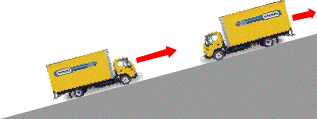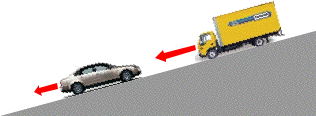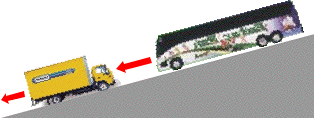 |
||
Passing in France
General
| Passing happens in 3 phases: 1. If the road ahead is clear, turn on the left turn signal and move to the lane to the left; 2. Pass on the left with your turn signal on the whole time; 3. Move back into the right lane with right turn signal on. |
| You always pass on the left. You may pass on the right only when the other vehicle is turning left. |
| On two-way roads with three lanes, the center lane is for passing. The far left lane is for oncoming traffic, so no passing there. And, of course, you do not use the passing lane if it's already occupied by someone passing from the other direction. |
| On highways with 3 lanes each way, the far left lane may not be used for vehicles longer then 7 m. That means trucks and/or cars pulling trailers must cruise in the far right lane and pass in the middle lane, but never enter the far left lane. |
Signs
 |
 |
|
| These signs mean no passing vehicles with more than 2 wheels (ignoring sidecars). | The no-passing zone ends at one of the signs above. Notice that exiting a town ends a no-passing zone. | You may not pass at train crossings without barriers. |
 |
 |
|
| You may not pass at intersections where you will have to yield. | But you are allowed to pass at intersections where you have right-of-way. Why this horribly unsafe practice is legal is not clear, but it is. | You are allowed to pass while crossing a crosswalk, as long as you make sure there are no pedestrians in it at the time. |
Markings On The Road
| SOLID LINES | You must never cross or straddle a solid line, just like in the U.S. Well, OK, there is actually an exception: You can cross a solid line to pass a fixed obstacle (broken-down vehicle, etc.). You, of course, exercise extreme caution in doing so. It is best to leave some distance between you and the obstacle to improve your visbility around it. You may not cross a solid line to pass slow vehicles, even farm equipment. See the MARKINGS ON THE ROAD section for a picture. |
| LINES OF DISSUASION | Closely spaced dashed lines mean you shouldn't pass. In the test especially, the only time you cross lines of dissuasion are to pass fixed obstacles (broken-down vehicles, etc.) or slow vehicles (bicycles, farm equipment, etc.). It is best to leave some distance between you and the obstacle / slow vehicle to improve your visbility around it. See the MARKINGS ON THE ROAD section for a picture. |
| ARROWS ON THE ROAD | If you see arrows pointing to the right telling you to merge right, do not start passing. You need to be done passing before the last arrow (usually there are three). Same if the lane you're in has arrows telling you to merge right -- you need to be done passing before you reach the last arrow. See the MARKINGS ON THE ROAD section for a picture. |
How To Pass
| You want to occupy the left lane for as short a period of time as possible. It is recommended that the vehicle you're passing be going 20 km/h slower than you. Since you cannot go over the speed limit, that means the other vehicle would be going at most 20 km/h below the limit. At 90 km/h, it would take 10 seconds to pass a vehicle going 70 km/h. |
| You need to make sure there is enough space ahead of the vehicle(s) you're passing for you to cut back into the right lane when you're done passing them. It is OK to pass multiple vehicles at a time, if appropriate. You must respect the distance of security between cars. We all know that if everyone followed these rules, no one would ever pass anyone else. But them's the rules, and you need to know them for the test. |
| When passing a pedestrian or bicycle rider, you must leave 1.5 m between you and them in the country, or 1 m in town. |
Being Passed
| If someone wants to pass you, don't try to prevent them, even if they aren't doing it right (e.g., on a blind curve). You squeeze to the right as far as possible to make it easier for them to pass and maintain your speed. Of course, you do not speed up either. At night, you switch to low beams when the other car passes you. |
Crossing Oncoming Traffic
General
| In general, you cross oncoming traffic on the right, squeezing over as far as practical to allow as much space as possible between you and the other traffic. If there is an obstacle in your lane, you slow or stop if necessary to let the traffic coming the other way pass before going around it. If the road is too narrow to let both vehicles pass, the more bulky vehicle (> 2 m wide or > 7 m long) must stop and let the smaller vehicle pass. |
Crossing On A Slope
|
Crossing Is Possible, Vehicles Are Same Category |
Priority of passage: |
|
| Crossing Not Possible Vehicles Are Of The Same Category (Uphill Vehicle Wins) |
Crossing Not Possible Vehicles Are Of Different Categories (Larger Vehicle Wins) |
  |
    |
|
|